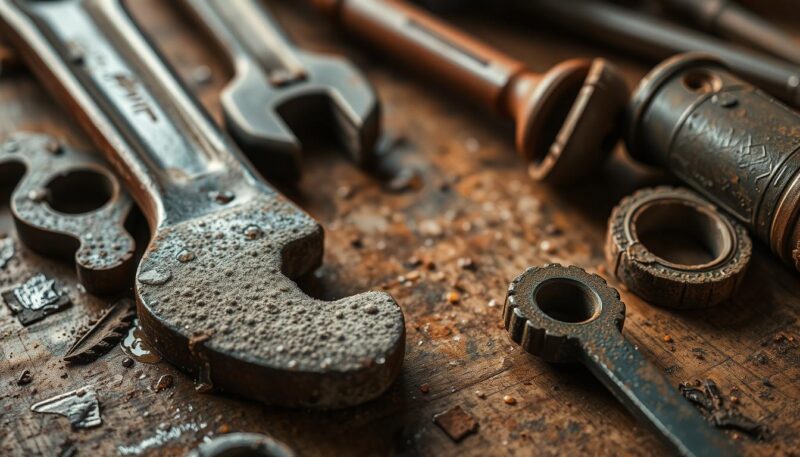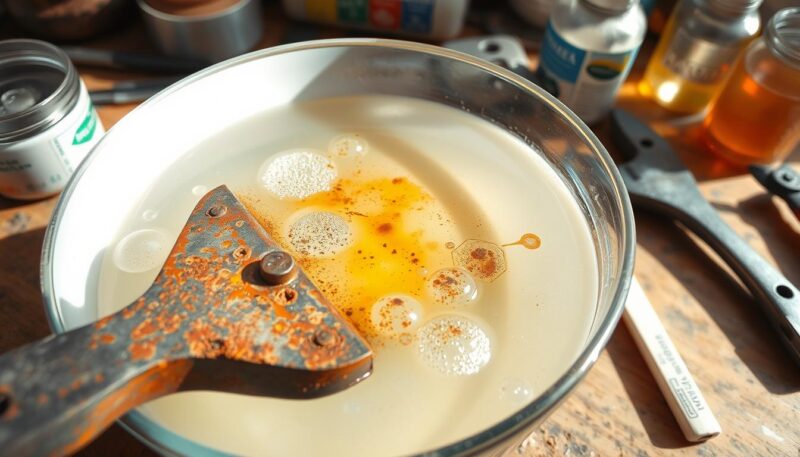Are you struggling with rusty tools? You’re not alone. Many homeowners face this common issue, but don’t let it get you down. Rust removal from tools is a crucial aspect of tool maintenance that not only saves you money but also helps restore tools that might hold sentimental value. A little effort can rejuvenate your rusty tools, making them look brand new and enhancing their functionality and longevity.
There’s no need to discard those valuable tools just because of some rust. From a Craftsman table saw purchased at a church auction for $80 to your reliable Makita GV5010 Disc Sander, many tools can be saved from the corrosion caused by prolonged exposure to moisture and oxygen. With the right methods and products, you can restore rusty tools effectively.
In this DIY guide for homeowners, we’ll explore various rust removal techniques, including using everyday items like white vinegar and more specialized solutions such as Evapo-Rust. If you’re into an eco-friendly approach, we’ve got you covered there too. By the end of this guide, you’ll be equipped with practical skills to tackle rust and maintain your tools in top-notch condition.
Ready to dive into the world of rust prevention tips and discover how to restore rusty tools? Let’s get started!
Understanding Rust and Its Impact on Tools
Rust, known scientifically as iron oxide, forms when iron or its alloys come into contact with moisture and oxygen. This seemingly inevitable process can transform your prized tools into rusty relics if not addressed promptly.
What is Rust?
Rust formation occurs due to a simple chemical reaction involving iron, water, and oxygen. Over time, this reaction, known as oxidation, produces a flaky, reddish-brown substance we recognize as rust. Although stainless steel and other metals do not rust, they can still corrode under certain conditions.
Common Tools Affected by Rust
Practically any tool with iron content is susceptible to rust. Common rusted tools include wood planes, chisels, and saws. Their frequent exposure to moisture during various DIY projects makes them prime candidates for rust formation.
Types of Rust and How They Form
- Surface Rust: This type of rust forms on the surface and is easier to clean. Simple rust removers like baking soda or a vinegar and salt mixture can be effective in dealing with surface rust.
- Scale Rust: Much more severe, scale rust penetrates the metal, leading to pitting and potential structural damage. Specialized treatments, sometimes involving commercial rust removers like oxalic acid, are required for deeper rust formations.
Effects of Rust on Tool Functionality
The impacts of rust on tools are far-reaching. Rust diminishes sharpness, reduces strength, and compromises precision, making tasks like cutting and carving more cumbersome. For instance, saws and chisels with rusted blades will be less sharp, leading to inefficient work and potential project failures.
The following table outlines some of the effects of rust on common rusted tools:
| Tool | Effect of Rust |
|---|---|
| Saws | Dulled blades, inefficient cutting |
| Chisels | Compromised precision, harder impact |
| Wood Planes | Reduced effectiveness, uneven surfaces |
Understanding the rust formation process and its impacts on your tools can help you take preventative measures to protect and extend the life of your valuable equipment. Keeping your tools dry, applying lubricants, and storing them in low-humidity environments are crucial steps in averting rust.
How to Get Rust Off of Tools?
Rust removal can be a simple task when approached with the right methods and products. Here’s a guide to help you keep your tools in pristine condition.
DIY Rust Removal Methods
DIY rust removal methods include utilizing common household items such as lemon juice, salt, baking soda, and white vinegar. Soaking tools in these solutions helps in breaking down the rust, making it easier to clean the surface.
Using Vinegar for Rust Removal
Using vinegar for rust removal is a highly effective technique. Soak your tools in white vinegar for several hours or overnight. For optimal results, adding a little salt to the vinegar can increase its acidity, enhancing the rust removal process.
Best Products for Rust Removal
For more stubborn rust, commercial products like Evapo-Rust and oxalic acid are highly recommended. Evapo-Rust is known for its effectiveness, especially based on numerous positive reviews. Oxalic acid requires the tools to be soaked for up to 20 minutes, using a ratio of one part acid to ten parts water.
Eco-friendly Rust Solutions
Eco-friendly rust solutions are becoming increasingly popular. Citric acid, for example, is favored for its mild nature and efficiency in rust removal. Techniques involving minimal chemical use, like sanding with emery paper or using steel wool, also help in achieving a high shine on tool surfaces while being environmentally friendly.
Step-by-Step Guide to Cleaning Rusty Tools
- Soak Tools: Submerge tools in white vinegar or a citric acid solution for a minimum of 24 hours for light rust, or up to three days for heavily rusted items.
- Scrub Surfaces: Use steel wool, a brush, or abrasive paper to remove loosened rust.
- Rinse and Dry: Rinse the tools thoroughly with water and dry immediately to prevent new rust from forming.
- Polish and Protect: Apply metal polish for a high shine and automotive paste-type wax to create a protective coating.
- Store Properly: Keep tools in a dry, climate-controlled space with moisture-absorbing gel packs to prevent future rust.
Safety Precautions During Rust Removal
Rust removal safety is paramount. Always wear plastic gloves and protective eyewear, especially when using strong chemicals like oxalic acid. Work in well-ventilated areas to avoid inhaling fumes, and ensure that your work area is equipped with necessary safety tools. Taking these precautions will help keep the rust removal process safe and efficient.
| Rust Removal Method | Items Needed | Duration |
|---|---|---|
| White Vinegar Soak | White Vinegar, Salt | 24 hours to 3 days |
| Oxalic Acid Soak | Oxalic Acid, Water | 20 minutes |
| Citric Acid Solution | Citric Acid, Water | 24 hours |
| Baking Soda Paste | Baking Soda, Water | 2 hours |
Conclusion
Regular maintenance is crucial for maintaining rust-free tools and extending their lifespan. Rust, a byproduct of oxidation due to exposure to water and oxygen, compromises both the functionality and aesthetics of your tools. As outlined, effective and eco-friendly techniques such as using vinegar or baking soda can help you tackle surface rust, which accounts for 62% of rust occurrences on tools. For deeper rust, employing mechanical methods like sandpaper or wire brushes, which 33% and 40% of people use respectively, can offer more robust solutions.
Maintaining rust-free tools through long-term tool care extends beyond rust removal. Proper storage, such as keeping tools in a dry place like a rolling tool chest, and regular maintenance routines—like applying WD-40 or machine oil, which 43% of respondents recommend—are essential preventive measures. Additionally, protective coatings like rust inhibitor sprays can create barriers against rust formation. Evaluating when to replace tools, rather than restoring them, becomes necessary when rust has severely compromised their functionality and safety.
Your confidence in managing tool maintenance should be bolstered through the understanding of these various methods. By adopting these strategies, you can preserve and restore your valuable tools efficiently. Regular checks for signs of wear and tear will significantly enhance your long-term tool care, empowering you to make informed decisions about whether to invest in new tools or extend the life of your existing ones through diligent maintenance and rust prevention techniques.


